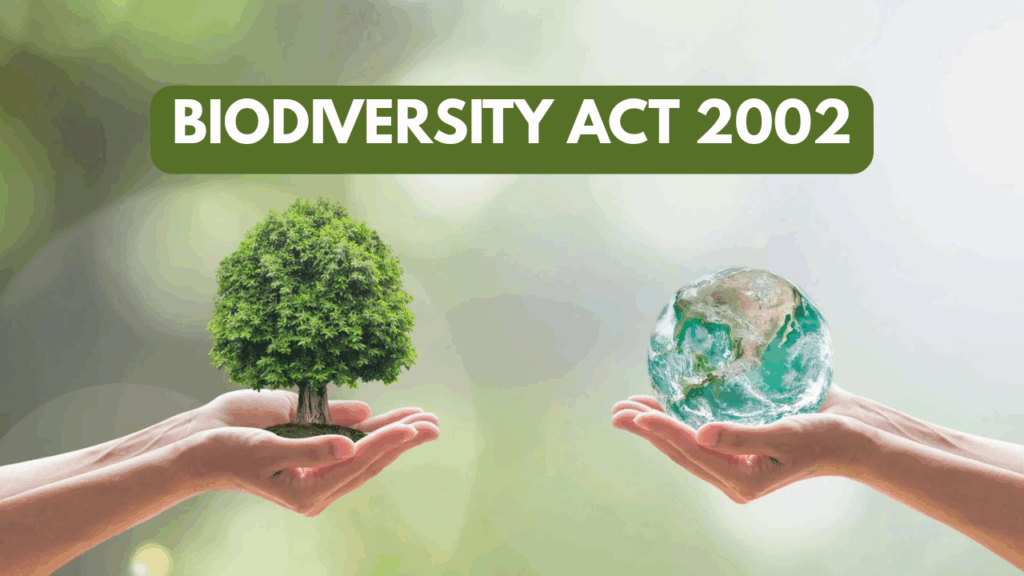
India is one of the world’s 17 megadiverse countries, home to nearly 7–8% of all recorded species. Recognizing the urgent need to safeguard its natural wealth, India enacted the Biological Diversity Act, 2002, aligning with its international commitments under the Convention on Biological Diversity (CBD), 1992. The Act sought to conserve biological resources, ensure sustainable use, and promote equitable sharing of benefits arising from their utilization. Over the past two decades, the law has made notable achievements, but significant challenges and gaps remain in its implementation.
Objectives of the Biodiversity Act, 2002
- Conservation of Biological Diversity – Protecting species, ecosystems, and genetic resources.
- Sustainable Use of Resources – Encouraging responsible utilization without overexploitation.
- Fair and Equitable Benefit Sharing (FEBS) – Ensuring that local communities benefit when their traditional knowledge or resources are used commercially.
Achievements of the Biodiversity Act, 2002
1. Institutional Framework
- Creation of a three-tier structure:
- National Biodiversity Authority (NBA) at the Centre.
- State Biodiversity Boards (SBBs) in States and Union Territories.
- Biodiversity Management Committees (BMCs) at local body level.
- This decentralised approach enabled community-level involvement in conservation.
2. People’s Biodiversity Registers (PBRs)
- BMCs maintain PBRs documenting local biodiversity and associated traditional knowledge.
- Over 3 lakh PBRs have been prepared, providing crucial data on species and practices.
3. Regulation of Access to Biological Resources
- Foreign entities and corporations must obtain prior approval from NBA to access biological resources or associated knowledge.
- This has curbed biopiracy and promoted accountability.
4. Benefit Sharing Mechanisms
- Provisions for Monetary and Non-Monetary Benefit Sharing when resources are used commercially.
- Example: Agreements with companies using traditional medicinal plants.
5. Linkage with International Commitments
- The Act operationalized India’s obligations under the CBD and Nagoya Protocol on Access and Benefit Sharing.
- Strengthened India’s position as a global biodiversity leader.
Gaps and Challenges in the Act
1. Weak Implementation at the Local Level
- While BMCs exist in large numbers, many function only on paper.
- Lack of capacity building, funds, and awareness hinders grassroots effectiveness.
2. Limited Awareness Among Communities
- Many local communities are unaware of their rights under the Act.
- Traditional knowledge remains vulnerable to exploitation.
3. Benefit Sharing Mechanisms Not Fully Realized
- Although benefit sharing is mandated, actual cases of fair distribution are rare.
- Corporations often find loopholes to bypass obligations.
4. Overlap with Other Laws
- Conflicts with laws such as the Forest Rights Act (2006) and Wildlife Protection Act (1972) create confusion in jurisdiction.
5. Industry Pushback and Dilutions
- Amendments proposed in 2021 sought to relax compliance norms for Ayurveda, Indian medicine, and research sectors, raising fears of weakening protections.
6. Monitoring and Enforcement Challenges
- Limited manpower in NBA and SBBs restricts their ability to monitor compliance.
- Illegal access to biological resources remains a concern.
Achievements vs. Gaps: A Comparative Table
| Aspect | Achievements | Gaps/Challenges |
|---|---|---|
| Institutional Framework | NBA, SBBs, and BMCs established | Weak functioning at local levels |
| Documentation of Biodiversity | Over 3 lakh People’s Biodiversity Registers | Quality and accuracy of records vary |
| Regulation of Access | Mandatory approvals for foreign entities | Loopholes and weak enforcement |
| Benefit Sharing | Provisions for monetary/non-monetary sharing | Rarely implemented, inequitable outcomes |
| International Commitments | Compliance with CBD and Nagoya Protocol | Domestic implementation gaps persist |
| Community Participation | Involvement through BMCs and PBRs | Lack of awareness, inadequate training and resources |
Way Forward
- Strengthen Local Institutions: Provide training, resources, and financial support to BMCs for effective functioning.
- Enhance Awareness Programs: Educate communities about their rights and the importance of biodiversity conservation.
- Ensure Effective Benefit Sharing: Transparent mechanisms must be developed to ensure local communities genuinely benefit from commercial use.
- Leverage Technology: Use digital platforms and GIS mapping for monitoring biodiversity and resource access.
- Harmonize Laws: Clarify overlaps with other environmental and forest laws to avoid jurisdictional conflicts.
- Promote Research with Responsibility: Encourage research and Ayurveda development while ensuring accountability and conservation.
Overview Table
| Key Area | Achievements | Gaps |
|---|---|---|
| Conservation Efforts | Institutional framework established | Weak implementation at grassroots |
| Documentation | 3 lakh+ PBRs prepared | Accuracy and maintenance issues |
| Benefit Sharing | Legal provisions exist | Rare practical enforcement |
| Community Involvement | BMCs empower locals | Lack of awareness and resources |
| International Obligations | Compliance with CBD & Nagoya | Domestic enforcement still weak |
| Policy Coherence | Strengthened conservation agenda | Overlaps with other environmental laws |
Conclusion
The Biological Diversity Act, 2002 has been a landmark in India’s conservation efforts, creating institutions, mechanisms, and policies that bring biodiversity into governance frameworks. Its achievements in curbing biopiracy, documenting species, and promoting international cooperation are significant. However, gaps in implementation, weak local participation, and ineffective benefit sharing dilute its potential. To secure India’s biodiversity heritage, the Act needs stronger enforcement, community empowerment, and better alignment with other environmental laws. Only then can it balance conservation with sustainable development in a meaningful way.
FAQs
Q1. What is the main purpose of the Biological Diversity Act, 2002?
It aims to conserve biodiversity, promote sustainable use, and ensure equitable benefit sharing.
Q2. What are People’s Biodiversity Registers (PBRs)?
PBRs are community-level records documenting local biodiversity and traditional knowledge.
Q3. What is the biggest challenge in implementing the Biodiversity Act?
Weak enforcement and lack of awareness among local communities remain the biggest challenges.

